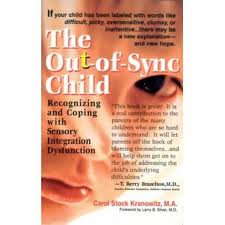Book Reviews: Out of Sync Child
We will review really good books in all areas of just for you, family life and learning styles. Here is one in the learning styles category on Sensory Processing Disorder or SPD.
The Out of Sync Child: Recognizing & Coping with Sensory Integration Dysfunction by Carol Stock Kranowitz, M.A., 1998 (now called Sensory Processing Disorder or SPD, re-released in 2006)
Why Do I like this book?
This book was a lifesaver for me, because it was one of the only books written about SPD for parents at the time when I needed it desperately. However, I have looked at many of the other books out there now and I still say this is one of the best.
The author, Carol Kranowitz, takes a mysterious issue and simplifies it in practical terms. She puts the parent in the driver’s seat when the parent feels anything but in the driver’s seat. She also gives bite size advice and sometimes, bite-size is all you can handle.
This book has been updated since I have used it to include additional information on visual and hearing deficits, motor skill difficulties, ADHD, Autism Spectrum Disorder, and other related disorders. Since SPD is typically combined with one of these other disorders, I think a great book just got even better.
In addition, Carol Kranowitz is still promoting speaking events and publications about SPD with co-authors and co-speakers. Her website is: www.out-of-sync-child.com
What to Expect from this book?
Part 1 of the book focuses on recognizing SPD and part 2 focuses on coping with SPD.
In part 1, Recognizing SPD, the senses are broken down into categories – far and near.
A) Far Senses
The far senses are those we understand readily such as: sight, sound, smell and taste. The near senses are tactile, vestibular and proprioceptive. The far senses remain together for checklists because they are really easy to recognize.
B) Near Senses
The near senses are separated into three chapters with the tactile sense affecting tactile perception, body awareness, motor planning, visual perception, academic learning, emotional security and social skills.
The vestibular sense* affects gravitational security, movement and balance, muscle tone, bilateral coordination, auditory-language processing, visual-spatial processing, motor planning and emotional security.
The proprioceptive sense* affects everyday skills such as: body awareness, motor control and planning, grading of movement, postural stability and emotional security.
The above is important because as a parent, I could not make the connection to each of these senses and their far-reaching effects. These three chapters helped immeasurably.
Also, this part of the book involves stories that you can relate to, tables that are easy to read, and checklists that are comprehensive.
Part 2, Coping with SPD
This part of the book involves documenting your child’s behavior and then seeking help from professionals. It also involves how you can help your child at home, in school and with their emotions. It lists many activities you can do with your child to improve his or her sensory diet.
All and all, if your child has SPD or you think your child may have SPD, I highly recommend this book.
*Note: I purposefully separated these two senses into different characters for Men in the Head ™ to provide clarity and weight to issues in these areas for parents.


